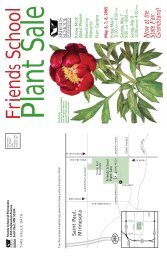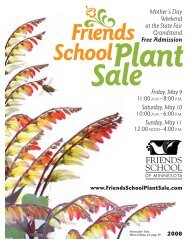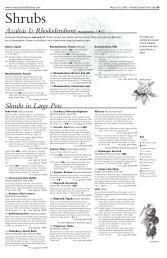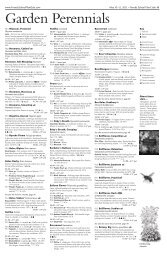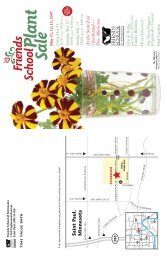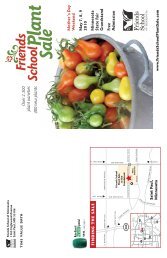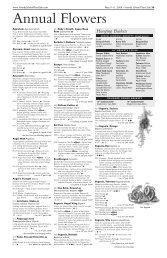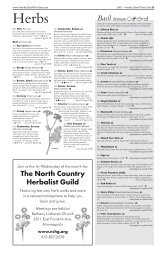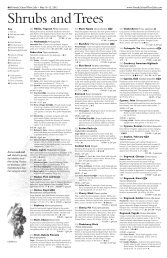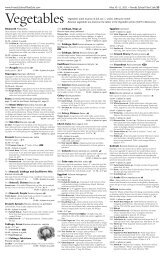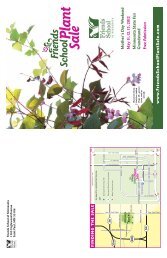View the 2013 56-page PDF here - Friends School Plant Sale
View the 2013 56-page PDF here - Friends School Plant Sale
View the 2013 56-page PDF here - Friends School Plant Sale
Create successful ePaper yourself
Turn your PDF publications into a flip-book with our unique Google optimized e-Paper software.
www.<strong>Friends</strong><strong>School</strong><strong>Plant</strong><strong>Sale</strong>.com May 10–12, <strong>2013</strong> • <strong>Friends</strong> <strong>School</strong> <strong>Plant</strong> <strong>Sale</strong> 7<br />
Rare and Unusual<br />
We accept cash, checks, Amex,<br />
Visa, MasterCard & Discover<br />
Peony, Woody Paeonia suffruticosa<br />
Woody peonies require at least four to five hours of sunlight<br />
daily. Good drainage is essential in a loamy soil with<br />
high humus content to a depth of at least 24”. Once<br />
established, you will be rewarded each year with an abundance<br />
of beautiful, huge flowers. Woody peonies can live<br />
more than a hundred years. Deer resistant. 36–60”h by<br />
48–72”w Í∏¥<br />
$30.00—1 gal. pot:<br />
U043 Chojuraka ◊—Huge lavender flowers.<br />
U044 Kaoukamon ◊—Maroon flowers.<br />
U045 Lavender ß<br />
U046 Purple ß<br />
U047 Red, ‘Houki’ ß<br />
U048 Yellow, ‘Kinshi’ ß—Brilliant yellow.<br />
$59.00—2 gal. pot:<br />
U049 High Noon ◊—Ruffled, satiny, semi-double<br />
6–10” yellow flowers with dark red flares at <strong>the</strong><br />
base of <strong>the</strong> petals and a gold-orange center.<br />
Lemon scent. Blooms early summer; unlike most<br />
woody peonies, it may rebloom.<br />
$79.00—1 gal. pot:<br />
U050 Leda ◊—Semi-double 8” pink-mauve flowers<br />
with dark plum colored flares. Slight lemony fragrance.<br />
Mid-season.<br />
U051 Terpsichore ◊—Named for <strong>the</strong> Greek Muse<br />
of dance, this peony has graceful single blooms,<br />
coral with orange and red veining. Fragrant. ∫<br />
U052 Pine, Japanese Umbrella<br />
Sciadopitys verticillata<br />
Like umbrella spokes, thick waxy glossy needles are<br />
clustered at <strong>the</strong> end of <strong>the</strong> branches. This rare evergreen<br />
conifer from Japan grows slowly but is long-lived<br />
and retains its green color in winter. Broad pyramid to<br />
narrow cone shape, but can also have multiple stems.<br />
Prefers a rich, acidic soil, and protection from winter<br />
winds. In ten years will reach 6–8’ tall. 20–30’h by<br />
15–20’w Í<br />
$20.00—1 gal. pot<br />
U053 Pinks, Mossy Dianthus freynii ß<br />
Spiky blue-green mossy carpet with tiny pink flowers<br />
in summer. Very dwarf. 2”h by 12”w Í ‰<br />
$2.00—2.5” pot<br />
Rhubarb, Rare Rheum ◊<br />
These are not your regular garden rhubarbs, though<br />
<strong>the</strong>y share <strong>the</strong> same edible stalks and poisonous<br />
leaves. Mulch well for winter. Í<br />
$5.00—2.5” pot:<br />
U054 Alexander’s Rhubarb, R. alexandrae—Spires<br />
covered with large dramatic creamy-yellow bracts<br />
make a long-lasting vertical statement. Likes<br />
moist to very wet places. Red fall color. 36–60”h<br />
$7.50—2.5” pot:<br />
U055 Sikkum Rhubarb, R. nobile—Striking translucent<br />
and overlapping creamy bracts form a greenhouse<br />
protecting flowers and seeds from harsh winds<br />
and UV radiation in its native Himalayan mountain<br />
habitat. Foliage makes a sweeping skirt at<br />
<strong>the</strong> base. 36–72”h<br />
Trillium, Rare Trillium<br />
Spring-blooming woodland flowers with three leaves.<br />
Give trilliums a rich, deep, ra<strong>the</strong>r moist soil and yearround<br />
leaf mulch. ∏ÓΩ‰¥<br />
$10.00—3.5” pot:<br />
U0<strong>56</strong> Sweet Betsy, T. cuneatum ◊—Striking dark<br />
red flowers form above enchanting mottled<br />
foliage in early spring. 8–12”h<br />
$22.00—1 quart pot:<br />
U057 Twisted Trillium, T. stamineum ß—Narrow twisty<br />
chocolate-maroon petals and prominent stamens.<br />
Lightly mottled leaves. Early spring. 12–18”h<br />
$22.00—4.5” pot:<br />
U058 Rainbow Trillium, T. sulcatum ◊—Dark redmaroon<br />
to purple-maroon flowers in May. <strong>Plant</strong>s<br />
may bloom in white, pink, cream, soft yellow or<br />
bicolor. The sepals are rolled inwards. Prefers<br />
slightly acidic soil. 12–24”h<br />
U059 Umbrella Leaf Diphylleia cymosa ◊<br />
Wide, umbrella-like leaves will add fabulous texture to<br />
your woodland garden. Dainty white flowers produce<br />
attractive blue-black fruit on red stems that persist<br />
through fall. 2–3”h ∏Ó¥ $10.00—3.5” pot<br />
U060 Yabumyoga Pollia japonica ◊<br />
Uncommon woodland plant from Japan has 8–12”<br />
glossy, blade-like leaves, clusters of tiny white flowers<br />
on stalks in late summer, and metallic blue-black<br />
berries. Spreads by rhizomes. May appreciate a winter<br />
mulch. 18–36”h by 24”w ∏Ó ˝Â $10.00—2.5” pot<br />
Tender Perennials<br />
These plants need to be over-wintered indoors; <strong>the</strong>y will not tolerate frost. It’s fun to<br />
outfox our Minnesota winters.<br />
U063 Cactus, Rope ◊<br />
Unknown species from Malcolm Burleigh<br />
An unusual hanging basket cactus from <strong>the</strong> garden of<br />
Saint Paul gardener Malcom Burleigh. Í<br />
$5.00—2.5” pot<br />
U064 Calla Zantedeschia aethiopica<br />
White 8” rolled goblets in spring and summer make<br />
elegant cut flowers. Large, arrowhead-shaped green<br />
leaves. Keep moist. 36”h Í∏ †¥<br />
$12.00—2 gal. pot<br />
Citrus Citrus<br />
Fragrant white flowers and ornamental, glossy foliage.<br />
Height depends on how many years you over-winter<br />
<strong>the</strong>m indoors. Need excellent drainage. ͆ǴΩ<br />
$25.00—1 gal. pot:<br />
U065 Lemon, Eureka—Sparkling green and white variegated<br />
leaves with pinkish new growth and buds.<br />
Immature fruit is green and yellow striped turning<br />
to yellow at maturity with tart pink flesh. ç<br />
$25.00—4” extra deep pot:<br />
U066 Kumquat, Nagami, C. fortunella—Savor <strong>the</strong> contrast<br />
of sour and salty in <strong>the</strong> fresh juicy olivesized<br />
fruit. Also used in preserves.<br />
U067 Lemon, Meyer, C. x meyeri—Compact size and<br />
productivity. Young leaves and shoots are dark<br />
purple. The yellow fruits are rounder and sweeter<br />
than a true lemon, with a slight orange tint when<br />
ripe. Fragrant, edible skin.<br />
U068 Lime, Kaffir, C. hystrix—Grown primarily for its<br />
attractive and distinctively shaped “double<br />
leaves.” Prized by Thai cooks, <strong>the</strong> leaves can be<br />
used fresh or dried and stored frozen. This small<br />
thorny tree is well suited to container growing. It<br />
can bloom year-round and may bear small, very<br />
bumpy green fruit.<br />
U069 Mandarin, Tango, C. reticulata—Sometimes<br />
called “zipper skins” because <strong>the</strong>y are so easily<br />
peeled. Self-fruiting and easy to grow if <strong>the</strong>y<br />
aren’t over-watered. Bright orange, nearly seedless<br />
fruit.<br />
U070 Desert Rose Adenium obesum<br />
Fleshy leaves and beautiful 2” pink trumpet-shaped<br />
flowers. The species name obesum refers to <strong>the</strong><br />
swollen base of <strong>the</strong> plant. This native of <strong>the</strong> arid areas<br />
of Africa is excellent in pots. Can get big over time in a<br />
pot if over-wintered. 18–36”h Í $18.00—6” pot<br />
U071 Dragon Tree Dracaena draco ◊<br />
A living fossil now found only in <strong>the</strong> Canary Islands<br />
and a few o<strong>the</strong>r places w<strong>here</strong> it is endangered, this succulent<br />
“tree” once lived in forests with <strong>the</strong> dinosaurs<br />
from Africa to Russia. Thick, scaly, ancient-looking<br />
branching trunk topped by dense rosettes of 24”<br />
swordlike, blue-green leaves. The Latin name means<br />
“dragon” and when its leaves, trunk or branches are<br />
cut <strong>the</strong>y trickle a crimson sap called dragon’s blood,<br />
used as a dye and medicinally. Slow-growing, easy,<br />
likes nutrient-poor, well-drained soil, and infrequent<br />
watering. 36–48”h Í<br />
$15.00—4” pot<br />
U072 Elephant’s Foot ◊<br />
Dioscorea sylvatica<br />
Enlarged fat root growing partly above <strong>the</strong> soil (<strong>the</strong><br />
“caudex”) develops a cool, crackled, gray-brown bark<br />
with age. A twining stem grows from <strong>the</strong> root with<br />
glossy, variably heart-shaped leaves that renew periodically.<br />
Clusters of tiny greenish-yellow flowers may<br />
bloom on a mature plant, but it’s mainly grown for <strong>the</strong><br />
bizarre root and ornamental foliage. From <strong>the</strong> edges of<br />
African forests. Watering keeps plant growing indoors<br />
in winter, but it can be allowed to go dry and dormant.<br />
72–84”h ÍÂ¥<br />
$15.00—4” pot<br />
U073 Eucalyptus, Rainbow ◊<br />
Eucalyptus deglupta<br />
Bonsai candidate with unique rainbow bark: strips of<br />
bark peel <strong>the</strong>mselves off, exposing light green inner<br />
bark which <strong>the</strong>n turns blue, orange, pink, red, purple<br />
and maroon. Most colorful in a tropical climate and on<br />
older trees, but fun to see what we get <strong>here</strong>. Bring<br />
inside for <strong>the</strong> winter. Í ¥ $32.00—1 gal. pot<br />
U074 Flamboyant Tree Delonix regia<br />
Butterfly-shaped 5” flowers in shades of red, orange<br />
and yellow will bloom even when <strong>the</strong> tree is dwarfed<br />
as bonsai or grown as a houseplant. Mimosa-like fea<strong>the</strong>ry<br />
leaves close up at night. When dormant in winter,<br />
keep tree completely dry. This is a tree whose height<br />
will vary depending on how many years you over-winter<br />
it. Syn. Poinciana regia. Í $15.00—4.5” pot<br />
U076 Ginger, Panda Face ◊<br />
Asarum maximum<br />
Velvety 2" black three-petaled trumpet flowers with a<br />
bold white central pattern are easier to see underneath<br />
<strong>the</strong> foliage in spring if grown in an eye-level container.<br />
Glossy silver-marbled 3" elongated heart-shaped<br />
leaves. This rare Chinese species needs humus rich soil<br />
and regular moisture. 6”h $29.00—3.5” pot<br />
U077 Loquat Eriobotrya japonica ◊<br />
Easy-to-grow subtropical fruit tree, grown for <strong>the</strong> bold<br />
tropical look of <strong>the</strong> textured foliage. Unusual in that it<br />
flowers in <strong>the</strong> fall. Fruit seldom ripens without a<br />
greenhouse. Good for bonsai. Small tree size. Í<br />
$36.00—1 gal. pot<br />
U078 Malagasy Fire Bush<br />
Uncarina peltata<br />
Golden yellow flowers with a purple throat resemble<br />
petunias or morning glories. Alien-looking seed pods<br />
have half-inch hooked spines. Lifting <strong>the</strong> thickened<br />
root system periodically creates a cool, gnarled bonsai<br />
look. Rich, well drained soil. From Madagascar.<br />
36–96”h ∏<br />
$4.00—3.5” pot<br />
U079 Monkey Puzzle Tree ◊<br />
Araucaria araucana<br />
In its native Chile, this “living fossil” conifer (related<br />
to <strong>the</strong> Norfolk Island Pine) can grow to be 150’ tall and<br />
2,000 years old, but you can have it in a pot. The tree<br />
has armor of overlapping sharply pointed leaves that<br />
cover its trunk and branches. ͆<br />
$20.00—4” deep pot<br />
U080 Pomegranate Punica granatum<br />
Wonderful—Miniaturized leaves and yellow-orange<br />
trumpet flowers. Self-fruitful, but if you want fruit,<br />
plant in a very large container. If trained as bonsai, <strong>the</strong><br />
tree’s twisting trunk takes on that desired ancient<br />
gnarly look and can be restricted to as little as 12”<br />
high. 24”h by 24–36”w Í † $15.00—1 gal. pot<br />
U081 Puya Puya alpestris<br />
Sapphire Towers—Silvery light green, spiny leaves;<br />
pineapple-shaped, turquoise green flower clusters with<br />
orange an<strong>the</strong>rs on erect 48–60” stems after 10 years.<br />
Requires abundant water and humidity. Treat as a succulent<br />
in winter, reducing water. 36”h Í∏ ˙<br />
$2.50—2.5” pot<br />
U082 Royal Paint Brush Haemanthus albiflos<br />
Fea<strong>the</strong>ry white blossoms begin in April and can last<br />
until July. But <strong>the</strong> show is not over. Clusters of bright<br />
red berries follow and can be enjoyed for many more<br />
months. Winter indoors. 12”h ∏ † $5.00—2.5” pot<br />
U083 Spider Lily, Carolina ◊<br />
Hymenocallis caroliniana<br />
Amaryllis relative that produces gorgeous clusters of<br />
6” white flowers resembling spidery daffodils. Prefers a<br />
moist location. 18–24” Í∏ ¥ $25.00—1 quart<br />
U084 Star of Lundi Pachypodium saundersii<br />
Sou<strong>the</strong>rn African native with white flowers and a thick,<br />
bulbous stem. A natural bonsai. 4-6’ in its native South<br />
Africa. 24–48”h Í<br />
$12.00—3.5” pot<br />
U085 Sweet Almond Bush ◊<br />
Aloysia virgata<br />
Intense fragrance reminiscent of baby powder.<br />
Numerous long white spires resemble a compact white<br />
butterfly bush. Fast growing, heavy blooming shrub<br />
from Argentina is treated as an annual <strong>here</strong>. May cause<br />
contact dermatitis in sensitive people. 24–72”h Í ∫Ω<br />
$6.00—4” pot<br />
We want to hear from you!<br />
Key<br />
Í Full sun<br />
∏ Part sun/part shade<br />
Ó Shade<br />
Ω Good for bees<br />
ı Bird food source<br />
∫ Butterfly-friendly<br />
˙ Hummingbird-friendly<br />
ç Attractive foliage<br />
Ç Culinary<br />
´ Edible flowers<br />
˝ Ground cover<br />
 Medicinal<br />
˜ Minnesota native<br />
‰ Rock garden<br />
† Cold-sensitive:<br />
keep above 40°F<br />
¥ Toxic to humans<br />
ß Saturday restock<br />
Calla<br />
We want to hear about your experiences with<br />
<strong>the</strong>se rare plants. Pictures and feedback will<br />
help us to decide what rare plants to offer<br />
in <strong>the</strong> future.<br />
Email to info@friendsschoolplantsale.com—thanks!<br />
Lemon





